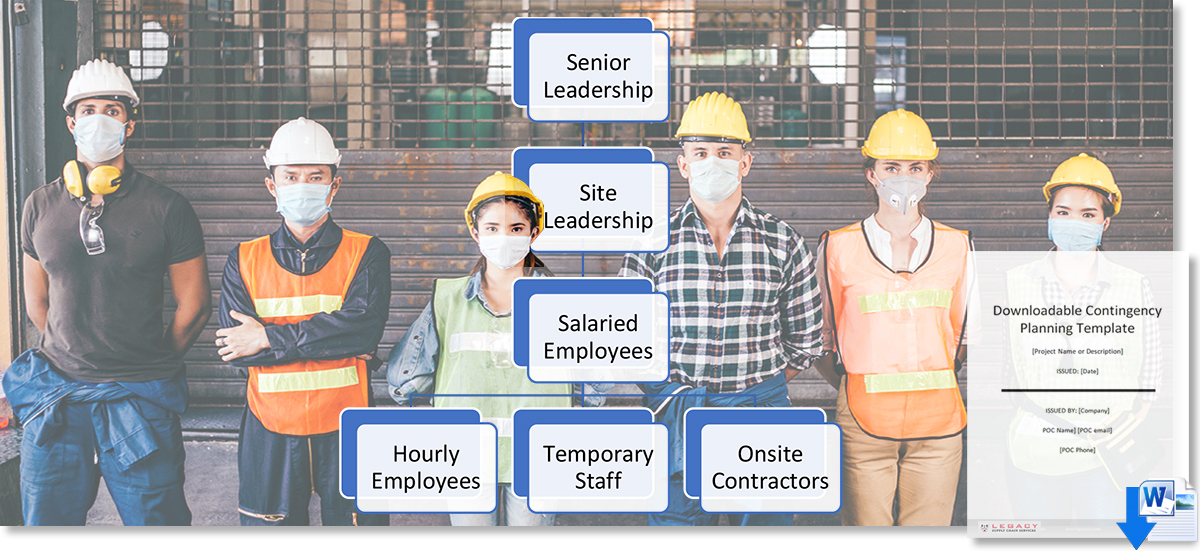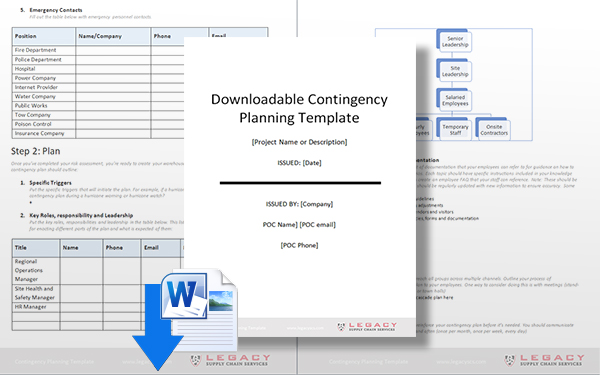3 Steps to Creating a Warehouse COVID-19 Contingency Plan - Assess, Plan & Communicate

The three key steps to creating a foolproof warehouse contingency plan are; assess, plan, and communicate - follow these steps so your business’ supply chain does not get disrupted.
Warehouse Contingency Plans:
You hope you’ll never need them; but without one, you’re stuck.
As even the mighty Amazon is forced to grapple with COVID-19 outbreaks, warehouses everywhere are forced to pivot in order to cope with stay-at-home mandates, labor shortages, and massive surges in demand.
This has laid bare the supply chain-wide need for comprehensive contingency plans - not only for COVID-19 but for emergencies of all kinds.
In this article, we’ll outline the three key steps to creating a foolproof warehouse contingency plan, so your business’ supply chain does not get disrupted.
Read the Article: Developing a Comprehensive COVID-19 Supply Chain Warehouse Logistics Contingency Plan
Step One: Assess
The first step to create an effective contingency plan is to perform a risk assessment within your warehouse.
Start by mapping out business-critical processes, procedures, technologies, and personnel to create a foundation for your warehouse contingency plan.
At the risk of stating the obvious, these operations are the cornerstone of your business and must carry on normally even in the event of an emergency.
Next, imagine various worst-case scenarios and formulate a response for each.
For example, how would your process for receiving shipments need to change in the event of a natural disaster? Regulatory compliance issues? A pandemic?
In addition to providing a foundation for your warehouse contingency plan, this assessment should also help you identify opportunities to reduce or eliminate risk before it even happens.
For example, in the case of COVID-19, strictly enforced workplace sanitation and social distancing protocols can prevent employees from getting sick on the job.
Step Two: Plan
Once you’ve completed your risk assessment, you’re ready to create your warehouse contingency plan.
Whether it’s in response to a global event or something as simple as an equipment malfunction, every warehouse contingency plan should outline:
- Specific triggers. These dictate what will set your plan in motion. For example, if you have a hurricane contingency plan, at what point does it go into effect - during a hurricane warning or a hurricane watch?
- Response strategy. Your plan should include a brief overview of how your warehouse staff should respond to the situation at hand.
- Key roles and responsibilities. Clearly define who is responsible for enacting different parts of the plan and what is expected of them. Be as specific as possible to prevent any confusion. This section of your contingency plan should clearly assign backups to all key positions and ensure that proper training has been conducted with all parties.
- Leadership depth and training. In addition to outlining responsibilities for executing your contingency plan, it’s also important to prepare the site so that it’s operational even when key leaders are not able to be present. Align primary and secondary fallback resources for mission-critical responsibilities and train your workforce accordingly. Continuous training and cross-training efforts within the warehouse will prove an invaluable time investment should disaster strike.
- Technology. One of the most critical elements of any warehouse contingency plan is a thorough schematic of all technology systems. Today, most of our data lives in the cloud, as do many business applications. To that, it’s important that you establish proper redundancy - in both your cloud-based storage and data centers - in the event that that data should become unavailable.
- There are many systems and connection points involved in creating transactions within a supply chain and providing visibility upstream and downstream from the distribution center. Your plan should address each of the systems you rely on - such as warehouse management systems, warehouse control systems, labor management, and timekeeping systems, enterprise resource planning systems, and transportation management systems - as well as any of the systems they connect to.
- Labor. Another critical element of a warehouse contingency plan is to have labor providers and staffing agencies in your back pocket. Take care to fully vet each vendor’s ability to provide qualified workers who won’t be disruptive to your team’s culture.
- Timeline. Explain to your employees when each step of your contingency plan should take place - for example, whether action needs to occur within the first hour of the plan being implemented or the first day.
- Alternative work schedules. Certain emergency scenarios, such as COVID-19, will require you to drastically reduce the number of onsite employees. Build alternative work schedules into your warehouse contingency plan to ensure that all of your business-critical operations are completed, even with a reduced workforce.
- Remote work arrangements. If there’s anything the coronavirus pandemic has taught us, it’s that every business - even warehousing - needs to have a plan in place for remote work arrangements. Your warehouse contingency plan should detail which workers are considered essential and which ones can work from home; be sure to provide the necessary resources and equipment to help remote workers get set up.
- Attendance requirements. Depending on the nature of the emergency, employees may be unable to attend work due to mitigating circumstances, such as a lack of child care, a compromised immune system, or fear of possible exposure. Employees who find themselves in this position may be reasonably concerned that their absence will affect their workplace performance. When creating your warehouse contingency plan, be sure to include information about attendance requirements and expectations and policies to address these concerns.
- Payment and benefits information. Similar to attendance, depending on the nature of the emergency, your employees may have concerns about payment and benefits. Take care to include specific information about both in your warehouse contingency plan.
- Corporate responsibility. For more high-risk scenarios, it’s important that you demonstrate to your staff that your organization is taking the necessary precautions to ensure their safety. Provide detailed explanations of workplace safety protocol, as well as offer a point of contact who can field employee questions or concerns.
- Evacuation plans. In some situations - say, a flood or a fire - it may be necessary to evacuate your staff from the warehouse. To accommodate this possibility, your contingency plan should include specific instructions on how to proceed, as well as clearly outline an evacuation route.
- Communication models. It’s important that your contingency plan maps out a structured flow of communication, and that you have prepared message templates readily available. This is imperative not only for internal communications but also for potential external communication should the situation garner media attention. We’ll go into this further in the next section.
Step Three: Communicate
Now that you have a fully formed warehouse contingency plan, it’s time to enact it across all levels of your business - and in order to do that, you must first clearly communicate it to all levels of your business. After all, it hardly seems reasonable to expect your warehouse staff to respond appropriately in the event of an emergency if your senior leadership team never provided specific instructions for how to do so.
The best way to do this is to start by determining the different groups within your warehouse. For example, your site leadership team might consist of a facility manager, an HR manager, an operations manager, and various supervisors. This group should be separate from your senior leadership team, which might consist of VPs and C-suite executives. You might also consider bucketing your warehouse staff into separate groups based on whether they’re salaried, hourly or temp workers or, alternatively, based on roles like receiving dock, inventory control, and shipping.
The next step is to create a tiered chain of communication so that individuals in leadership positions have a clear understanding of whom they’re responsible for delivering information to. A typical warehouse organizational structure will look something like the following:

Now that you have the “what” and the “who” of your warehouse contingency plan, the next step is to figure out the “how” and the “when.”
Let’s start with the “how.” There are any number of ways to communicate your contingency plan to your warehouse staff, however, with so many moving pieces in a warehouse environment, it’s important to think through a few cornerstone elements.
Knowledge Base and Documentation: Your knowledge base should consist of documentation that your employees can refer to for guidance on how to respond to different disaster scenarios.
For example, every COVID-19 response plan should include:
- Sanitation guidelines
- Social distancing requirements
- Travel and work-from-home guidelines
- Protective standard operation procedures, including temperature screenings and protective face coverings
- Attendance and time off policy adjustmentsExposure case definitions and contact tracing procedures
- Employee “safe passage” documentation and essential business definition (with guidance on applicable local, county, state and federal legislation)
- Protocol for handling an infected associate in the workforceProtocol for handling onsite vendors and visitors
- Related human resources policies, forms, and documentation
Therefore, your warehouse contingency plan knowledge base should include documents with specific instructions on each of these topics. It’s also recommended that you create an employee FAQ that your staff can refer to if they have additional questions about your contingency plan. An important note: These should be considered living documents and should be regularly updated with new information to ensure accuracy.
See How LEGACY Supply Chain Services is responding to COVID-19 with its own Contingency Plans
Communications Cascade: An effective communications cascading process will reach all groups across multiple channels. Meetings - be they stand-up meetings, workgroup meetings, or town halls - are another effective way to communicate your warehouse contingency plan to your staff. This method of delivering information is not only more immediate, but it also gives employees the opportunity to ask questions and gain a better understanding of how to proceed.
We also recommend that you incorporate visual communication wherever possible since studies show that 67% percent of employees are better at completing tasks when communicated by video or by text with images rather than plain text alone. Ideally, your warehouse contingency plan communication effort should be multi-faceted so that messaging is consistently reinforced.
Given that the CDC’s social distancing requirements have made it impossible for staff to meet in person, it might also make sense for you to invest in technological solutions that make it easier for your employees to communicate virtually, such as instant messaging or video conferencing services.
Reinforcement: With the “how” out of the way, the “when” is fairly straightforward: You should communicate your organization’s contingency plan to warehouse staff well in advance of an actual emergency. There’s really no way to accurately predict when disaster might strike, so it’s important that your employees be prepared no matter what. Communicate with your employees early and often, whether that’s once a month, once a week, or even every day - however long it takes for the information to really sink in.
Engagement: Most communication efforts are minimally effective if there’s no two-way dialogue. It’s important that you create a feedback channel and use the resulting information to develop active next steps. Surveys, quizzes, train-the-trainer events, role-playing, suggestion boxes, contests… There are countless ways to establish a two-way dialogue to reinforce the understanding of and get your employees to engage with your contingency plan.
Testing: Contingency planning and business continuity are all about preparation and diligence. Although it might seem like overkill, creating mock scenarios in which key staff members are required to activate certain elements of your contingency plan can prove invaluable should you ever have to actually enact it. From practicing technology fail-overs to being able to pick and process orders manually to moving large groups of people to a safe area, there are a number of ways to practice your warehouse contingency plan ahead of time in a controlled environment.
About the Author
Kyle Krug has 20 years of professional experience in marketing & strategy, technology & information management, business development, and operational support positions in B2C and B2B services industries. Kyle Krug leads Marketing & Communications for LEGACY Supply Chain Services, with past roles as the Director of Client Solutions for Griffin Global Logistics, and Marketing Manager/Data Analyst in the Hotel Casino industry.
Related Article: COVID-19 Pandemic Sheds New Light on the Need for a Supply Chain Logistics Contingency Plan
Related Resource
Warehouse Contingency Planning Template
We’ve taken the guesswork out of warehouse contingency planning with this downloadable editable template; from performing a risk assessment to testing out mock emergency scenarios, we’ve detailed every step of the process and made it easy for you to document policies and procedures, so you’ll know exactly what to do should disaster strike. Download Now!
More Resources from LEGACY Supply Chain Services
Article Topics
LEGACY Supply Chain Services News & Resources
Outsourcing eCommerce Fulfillment to a 3PL Rapidly Improve the Performance of Your Warehouse Logistics 20 Warehouse & Distribution Center Best Practices for Your Supply Chain Warehouse Contingency Planning Template 7 Last Mile Logistics Delivery & Ecommerce Trends You Don’t Want to Overlook Increase Inventory Visibility across Your Supply Chain and Optimize Omni-Channel Fulfillment Omni-Channel Logistics Leaders: Top 5 Inventory Insights More LEGACY Supply Chain ServicesLatest in Warehouse|DC
Ranking the World’s 10 Biggest Supply Chains The Top 10 Risks Facing Supply Chain Professionals Walmart’s Latest Service: Ultra Late-Night Delivery Dollar Tree’s Oklahoma Distribution Center Decimated by Tornado European Parliament Passes Law on Supply Chain Accountability Transforming Warehousing with AI: Five Key Reasons to Adopt Now Talking Supply Chain: Understanding the FTC’s ban on noncompetes More Warehouse|DC















